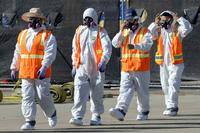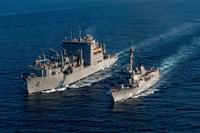
The Pentagons Missile Defense Agency tested a key leg in its missile shield triad yesterday, shooting down both a sub-sonic cruise missile in the atmosphere and a ballistic missile in space with a ship-based interceptor.
To say the least, missile defense has been extremely controversial over the years, and it is a subject of heated debate over whether the hundreds of billions of dollars spent on systems over the years have been worth the cost.
But it is worth chalking up this test in the win column for the embattled agency.
From a Raytheon release:
In a first of its kind dual missile defense test, Raytheon Company-produced Standard Missile-3 (SM-3) and Standard Missile-2 (SM-2) simultaneously engaged targets over the Pacific Ocean.
This was the first time a U.S. Navy ship demonstrated simultaneous ship engagements against both cruise and ballistic missile targets. It was the eighth successful intercept for the Aegis Ballistic Missile Defense systems SM-3.
The SM-3 Block IA destroyed a short-range ballistic missile target in space while SM-2 Block IIIA engaged a cruise missile threat at a lower altitude. Both intercepting missiles were fired from guided missile cruiser USS Lake Erie (CG 70) by the ships crew. The ballistic missile target was launched from the U.S. Navys Pacific Missile Range Facility on Kauai. The subsonic cruise missile target was launched from a range aircraft.
This test, Flight Test Mission-11, was the second with the Block IA version of SM-3, and the first IA with a full-capability solid divert and attitude control system. Raytheon is delivering Block IA rounds for operational use on Navy cruisers and destroyers.
The SM-3 Block IA provides increased capability to engage short- to intermediate-range ballistic missiles. The SM-3 Block IA incorporates rocket motor upgrades and computer program modifications to improve sensor performance, missile guidance and control, and lower cost. It also includes producibility and maintainability features required to qualify the missile as a tactical fleet asset.
Its definately worth noting the complexity of such a test. Two different kinds of missile threats, tracked by the Aegis radar system that was feeding information to two different interceptors - each with its own seeker technology - to a terminal kill. Experts on both sides of the debate recognize the sterility of such tests. In the real world, adversaries might incorporate decoys and other defenses to keep their missiles from being shot down.
But, despite the incredible costs, its important to remember that well-meaning people are hard at work trying to solve a problem and a threat that has so far kept most nations helpless to confront militarily.
(Gouge: MS)
-- Christian








